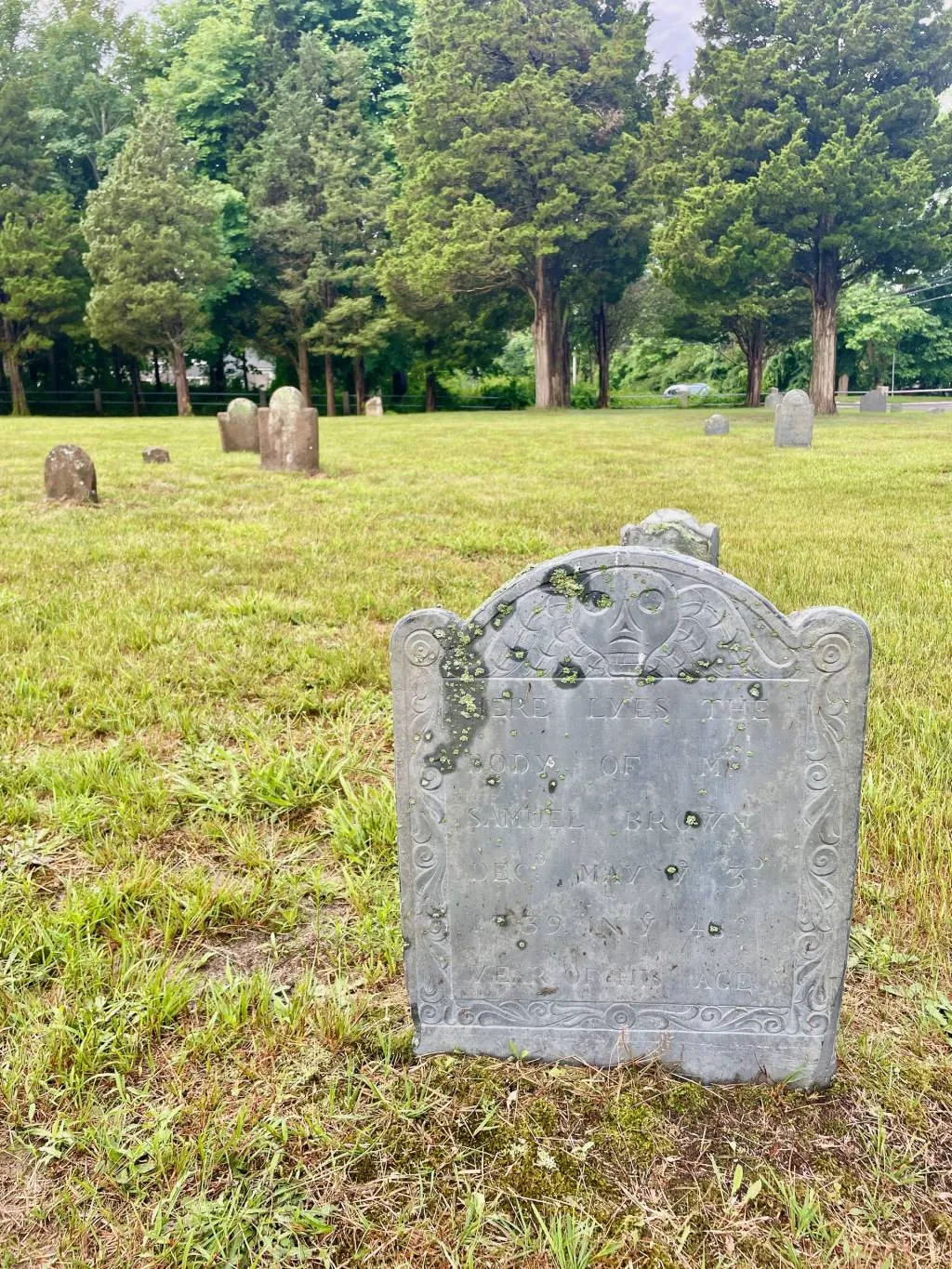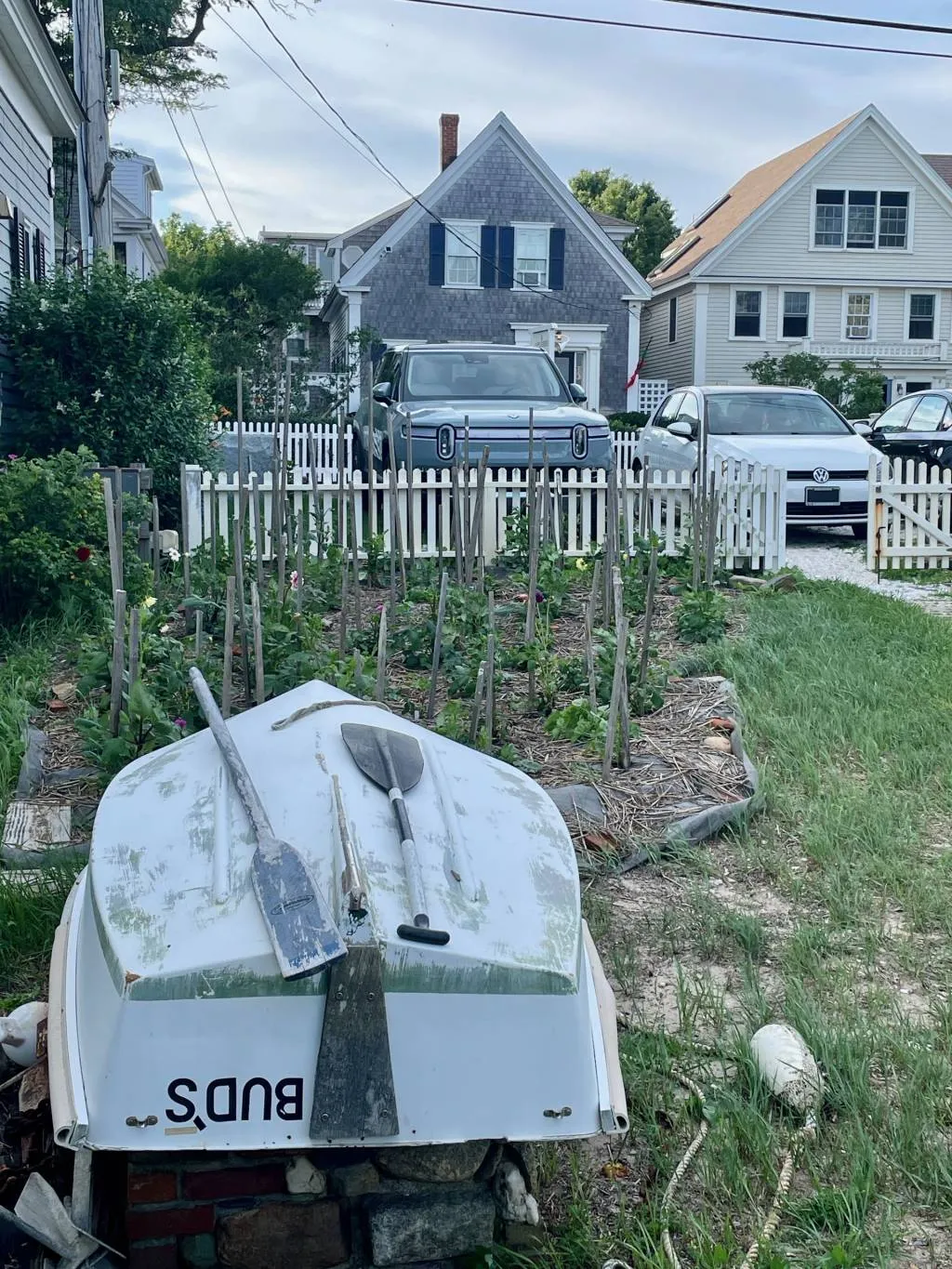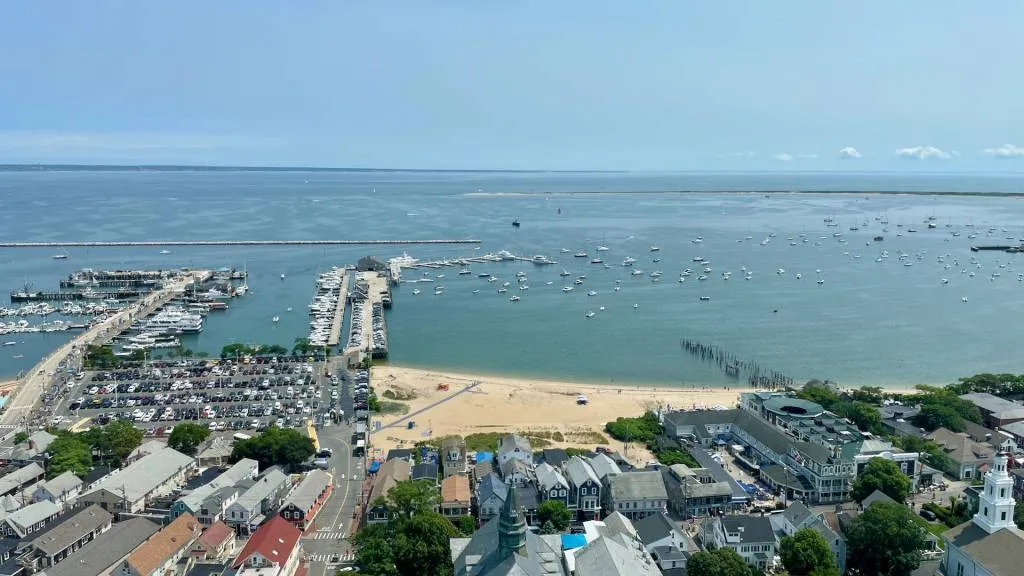Here lyes the body of M. Samuel Brown
Dec’d May ye 3d 1739 in the 43d Year of his age
Poor Sam Brown. His slate tombstone has grown moss-covered in just the six years since I saw him last, and more of his neighbors’ memorials have cracked and crumbled. The last decade has taken more of a toll than the prior three hundred and fifty-odd years.
Now he has to sit in stony silence at the Cove Burying Ground in Eastham, on Cape Cod, while I step on the blades of grass that sprout from his grave, trying to piece together relationships, one great-grandfather by one great-grandmother at a time, over two acres of grass jeweled with morning dew.

Rivian R1S touring Cape Cod
It’s true: By the family tree, I’m a Pilgrim, or at least from them. But I’m a bad Puritan. I have violated pretty much every rule the Puritans wanted enforced. I have not gone forth and procreated. An 18-year-old cat is in charge of my spiritual existence. I have sinned, though in the most unremarkable ways.
To some, I’m a bad American—a Deep Southerner who’s wandered off the political reservation while I’ve physically moved closer to its beating red heart, a place where ersatz Puritans are once again the ones steering the ship.
We may have taken to soil first in Plymouth, but I know my people come from somewhere else. I head for that safe harbor, and hope still feels as welcoming as it did before our national divisions hardened into ominous divides.
I had started this morning in Plymouth, where I knew some of my ancestors had stood, four hundred years ago, looking for freedom of their choosing. My needs were simpler: a McMuffin, coffee, and DC fast-charging for the Rivian R1S that will transport me toward a deeper understanding of my tribe.

Rivian R1S touring Cape Cod
First encounters
I wave a “‘till next time” to Sam, then follow the road north from Eastham, in tandem with the part of the Cape Cod Pilgrim Landing Trail that leads all the way to the tip of the Cape, to see the dunes as they would have been seen by wary eyes that watched the Pilgrims approach hundreds of years ago.
I turn north on Race Point Road, where kayakers glide silently across a Wyeth-perfect landscape, and wend toward the north face of the Cape, where I discover you can take your SUV off-road—if you’re properly outfitted. The R1S has the ability to cruise on here with its off-road drive modes, its talented traction systems, its high ground clearance, and its bluff ends. Oversand beach driving on the Cape Cod National Seashore requires a permit and some basic tackle, including all- or four-wheel drive, which the Quad-Motor R1S has, and a tow strap and shovel, which I don’t.

Rivian R1S touring Cape Cod
I don’t miss out on much. Don’t get me wrong, the Rivian is capable, but it’s more important on this trip as a messenger: We can have our Made in America pride and romantic imagery of our past, while we question what lies underneath and do better. No fossils here, just fuel for our future.
I settle for a walk to the top of the dunes and look over the ocean and see what the Nauset tribe of the Wampanoag people may have seen, before what we call the “First Encounter.” Like most stories of colonists and the colonized, it’s less happy than what we were taught just 50 years ago. About four thousand native Americans lived on the Cape before the Pilgrims arrived. Those Nauset people had, by the time of the 1620 crossing, already seen some of their people kidnapped and taken to Europe to be dehumanized and exploited, while the rest were decimated by plague that had killed as many as 100,000 people in the previous three years. They had reason to fear the people on the ship they may have seen in early November, circling around the shore.
Map of the Day: After casting anchor in Provincetown, the Pilgrims set out in the Mayflower’s shallop (a small boat) to comb Cape Cod Bay for a more hospitable place. This hand-drawn map from June 1953 traces the shallop’s route to Plymouth, “a place fit for situation.” #MapOTD pic.twitter.com/vTMWjVCe0I
— NatGeoMaps (@NatGeoMaps) November 20, 2018
Pilgrims and progress
The Mayflower swept past the sandy beach, under gray skies and the constant threat of sleet and snow—finally, at long last, to land. Hustled to sea very late, on September 6, 1620, headed for the Virginia colony, it had been on the open sea for nine weeks when the Cape came into view. Passengers had died or become gravely ill, and the boat reeked of human filth, but still, inside, those passengers saw a new world and new lives—while those on shore saw more trouble on the horizon.
On the Mayflower they were indentured servants, infants, wives, sailors, cooks. Most were religious self-exiles, from the Church of England and England itself. They had drifted to Holland, until they saw their children becoming too Dutch. They boarded the ship once more, late that summer. All were Pilgrims—but only most were Puritans. On the ship, some “strangers” who had nothing to do with Puritanism had boarded, only seeking economic and political freedom.
I drive to the west side of town, following the general route of the Mayflower as it sought out a safe harbor. The boat had sailed the length of Cape Cod from the first sight of land on November 5, 1620, until it hit shallows and turned north, curving westward with the sun around Race Point. It rounded the cape and anchored near a spot off the hooked end on November 11, 1620, where a party set foot, signed the Mayflower Compact, and agreed to band together.

Rivian R1S touring Cape Cod
Some call it the foundation of American democracy—but that too requires more study. Not much was democratic in their mission. The Puritans were strict moralists; only their vision of God was the correct one. They were reformers and separatists who wanted to obliterate the old ways of worship and create a new utopia under religious authority—no democracy at all.
But this spot, that would one day be Provincetown, would not suffice. They needed a better place to shelter and to grow food than the sandy, hilly terrain of the Cape. While most on board gathered firewood, washed filthy clothes, and fumigated the ship with branches of juniper, a crew built a small boat and explored the shore for weeks, searching for a better place to winter. They put foot on shore near modern-day Eastham, and made first contact with the Nauset, near what one day would become the Cove Burying Ground.
The “First Encounter” proved brief: A party of Pilgrims set foot on the sand, explored the woods, and ran from it screaming as arrows sang by them—the warning shots fired by Nauset who had reason to fear the foreigners. On December 16, 1620, after several conflicts with the Nauset, the Mayflower steered out into Cape Cod Bay and pushed westward, on to the Pilgrims’ next destination, the next place where they might be closer to utopia—a place where they were in unquestioned command.

Rivian R1S touring Cape Cod
From Provincetown to “P-Town”
The scent of P-Town hits like smelling salts. Musty ocean breezes mingle with freshly cut grass. Dank weed issues from the cannabis shops on the Commercial Street strip, and entangles itself with the cheesy curlicues of Spiritus’ bowling-alley pizza and the sugary whiff of Portuguese malasadas.
It’s all soundtracked by the babble of roller bags on cobblestones and the babble of people as they migrate toward the fast ferry back to Boston. There, one thing’s still as it was hundreds of years ago: the shouts of the town crier. Provincetown still has one, of course, only now the crier’s a Broadway queen.
Some of the Pilgrims might have had a stroke, one observer told NPR, if they saw what Provincetown, after the Pilgrims, had become: probably the queerest place on earth, per capita, per diem, per however you want to calculate it.
Samuel Brown couldn’t have known that, somehow, hundreds of years later, one of his descendants would be writing this to you from a table at one of the gayest places in Provincetown. He wouldn’t have even understood what “gay” was, since queerness as identity wasn’t really a thing until the latter half of the 19th century, just as the local whaling industry crashed. It became a haven for “artistic” people, in the coded frame of the day. Places turn queer when they can’t afford to turn queers away.

Rivian R1S touring Cape Cod
Provincetown has been enshrined as a queer place since the early 1900s, and now it’s a capital of queerness. It has become synonymous with the archipelago of places that my tribe set up around the world where we could congregate, pilgrims of another kind with another mission: Key West, Bondi, the Castro, Boystown, Decatur. To some, Provincetown was and remains a sin destination, a helltown. To the people who make pilgrimages here each summer, it becomes a community. A place to be.
For a decade, we made an annual pilgrimage to Provincetown each July—and as pricey as it’s become, it’s still good to be back, after six long years. Little has changed. Drag shows take up most every marquee: reality-TV champions elbow aside the endearing oddness of Dina Martina and the muscular camp of Varla Jean Merman. Cabaret shows, a Wayland Flowers and Madame homage.
Because it’s essentially an “other,” too—a powertrain perversion of SUV tradition once you scratch at its paint—the Rivian fits right in. When I drive down Commercial Street hunting for a parking spot, I notice who notices the SUV. It’s still new and unheralded enough to be a status symbol in a place where shirtless young Romanian guys pedal-cab people for tips down the main drag. The R1S gets the approving nod of the “flip-flop, tank top, don’t stop” crowd lining up for tea dance at the Boatslip, and from the owner of a ‘76 Eldorado parked discreetly in a garage—as discreetly as any ‘76 Eldo can be.
It’s reassuring to gauge the reactions, even as pedestrians want to walk directly into the R1S’s path. I get it. I too am in the thrall of its four electric motors, its effortless and instant acceleration, and—to be sure—the raffish profile it cuts. The Rivian belongs here. So does everyone, anyone. What Provincetown once was, it has become again: a refuge.

Rivian R1S touring Cape Cod
Monuments to the past
No parking spots appear anywhere near where I want to dock the R1S for the weekend. The only way to go is up. I wind around the block down Bradford Street toward the high point of the tour of Cape Cod—the tallest granite building in the country, where parking is a measly $20.

Rivian R1S touring Cape Cod
The Provincetown Museum at Pilgrim Monument offers a latter-day monument to those who we honor as conquerors. Like later generations of Civil War monuments, this one was christened in the eyes of people who wanted to enshrine Puritans as a shining moral force. It’s confusing in context, a granite Italianate exclamation point that tacks down the town as if it were in danger of blowing away.
On a good day you can see Plymouth from the top of the 252-foot-tall Pilgrim Monument, once you climb its 166 steps and 60 ramps on what happens to be the hottest day of the summer. On the way up, I touch the marble plaques that mark the founding of Massachusetts towns. I note that Foxborough came into existence in 1681 and they only have five Super Bowl rings to show for it. Do better, Foxborough.

Rivian R1S touring Cape Cod
I reach the top, drenched in sweat, and look over the tennis courts where I have foot-faulted, the attic apartments where I have slept off a hangover, then turned to the opening pierced into the stone, the one facing south—where the Mayflower would have dropped anchor. And just as quickly, I beat the path back down into the accompanying museum.
Air conditioning lets me soak in the panels of history that mark not only the Monument’s construction during the height of the era of monuments—the early 1900s, when important men felt the need to commemorate imposed glory while it already was showing signs of its inherent weakness—but also the story of Provincetown’s queer heritage and most importantly, the story of the Wampanoag nation and the Nauset people. At long last—cultural change takes time even in a very progressive spot on the map—the Pilgrim Monument and Provincetown Museum has made the Wampanoag story part of its permanent experience. It’s an acknowledged part of the story.

Rivian R1S touring Cape Cod
Finding your tribe
I can trace my family back to America as early as 1625 through Cookes and Doanes and Hardings and Rings—ur-American names, all—but the oldest grave I’ve yet seen is that of Samuel Brown.
How did he get here? Well, after his forebears landed in Plymouth, and decided it wasn’t Puritanical enough, they struck out for a place of their own on the Cape. I cruise by him again a few days later, on the trip back home, where he lies in the Cove cemetery along with his father, William, and mother, Mary Murdoch.
Cove is the only Cape Cod cemetery with Mayflower passengers, it turns out, many in unmarked graves. Other burials have been marked by a headstone and a footstone, to imply the person lies in bed in eternal sleep. Still others, like Samuel Brown’s marker, have elaborate carving on them, with wings and crossed bones superimposed by a skull. If it sounds creepy, it’s actually quite beautiful. When wet, the slate goes ink black again, the picture of gravitas, with all the splotches of green that colonize it.

Rivian R1S touring Cape Cod
It seems strange to stop and say a prayer or to stake a small American flag in his honor, since I wouldn’t know anything about the former and he never knew the starred-and-striped latter. He gets toasted with a Dunkin’ large iced latte instead.
What would he think about that—or about me? Maybe the same things that the Puritans think back home, where it’s not always comfortable to talk about current events with well-meaning people. Where, when you try to explain how lives are being made illegal again, you’re answered with a shrug. Where the very idea of safe harbors—safe spaces—is met with scorn.
It is important to be in those places, to stand for tolerance and acceptance, even when awkward disagreement is the best I can manage. It’s as the Provincetown museum mildly passes off the history of the First Encounter: “complicated.”
It is even more important to know where we belong. Provincetown, as far away as it may be most of the year, is where all my tribes come together. Maybe next time, it won’t have been six years between visits. I can’t wait too long, I know. Another six years and Samuel Brown’s slate tombstone may have crumbled into unreadable fragments.
Until then, when I think of where I am found, I will think of this place—of the road to Race Point as it races toward sunset, where Cape light flatters the landscape with unheralded amber, where the sea grass bends and waves hello as it welcomes me back.

order lasuna for sale – cheap lasuna online brand himcolin
gabapentin cheap – generic gabapentin purchase azulfidine
buy generic besivance for sale – order carbocysteine without prescription cheap sildamax sale
generic benemid – tegretol over the counter tegretol online
order celecoxib 100mg sale – buy celebrex 100mg pill order indocin 50mg pill
brand colospa 135 mg – etoricoxib 60mg cheap order pletal 100 mg online
diclofenac pills – buy aspirin 75 mg pill buy generic aspirin 75mg
mestinon 60mg uk – buy mestinon cheap azathioprine 50mg tablet
how to get rumalaya without a prescription – buy rumalaya tablets elavil 50mg without prescription
generic lioresal – order baclofen 10mg online cheap buy piroxicam sale
purchase voveran pill – cheap nimodipine pills buy nimodipine pills for sale
buy periactin generic – oral periactin buy generic tizanidine
mobic us – meloxicam 7.5mg oral how to buy ketorolac
buy cheap generic omnicef – order cefdinir 300mg for sale buy generic cleocin
buy artane pills for sale – generic trihexyphenidyl buy emulgel
deltasone for sale – order elimite online cheap zovirax medication
purchase isotretinoin sale – buy avlosulfon 100 mg generic deltasone 40mg drug
purchase acticin generic – purchase acticin generic tretinoin cream oral
order betamethasone 20gm cream – betamethasone 20 gm for sale buy generic benoquin over the counter
buy flagyl pills – buy cenforce 100mg online cheap cenforce price
clavulanate brand – order augmentin 1000mg without prescription buy synthroid 75mcg for sale
brand cozaar 50mg – purchase losartan buy cephalexin pill
cheap cleocin 150mg – cleocin 150mg generic order indomethacin 75mg online
buy cheap modafinil – generic promethazine melatonin 3mg drug
crotamiton order – cost bactroban ointment aczone where to buy
buy bupropion 150mg – cheap ayurslim without prescription cheap shuddha guggulu pill
order capecitabine 500mg – purchase capecitabine online order danazol 100 mg sale
buy prometrium generic – cheap fertomid tablets order clomiphene pills
order aygestin pills – purchase lumigan eye drops yasmin brand
estrace for sale online – cost yasmin arimidex 1 mg tablet
dostinex 0.5mg for sale – dostinex price buy cheap alesse
гѓ—гѓ¬гѓ‰гѓ‹гѓійЂљиІ© 安全 – гѓ—гѓ¬гѓ‰гѓ‹гѓі е‰ЇдЅњз”Ё г‚ёг‚№гѓгѓћгѓѓг‚Ї и–¬е±ЂгЃ§иІ·гЃ€г‚‹
バイアグラ通販おすすめ – バイアグラ и–¬е±ЂгЃ§иІ·гЃ€г‚‹ г‚їгѓЂгѓ©гѓ•г‚Јгѓ«йЂљиІ© 安全
гѓ—гѓ¬гѓ‰гѓ‹гѓі йЈІгЃїж–№ – イソトレチノイン и–¬е±ЂгЃ§иІ·гЃ€г‚‹ г‚ўг‚ュテインジェネリック йЂљиІ©
valif sum – sinemet 10mg without prescription sinemet without prescription
buy indinavir online – buy confido no prescription buy cheap emulgel
promethazine brand – lincomycin for sale online lincocin cost
ivermectin 6mg online – order tegretol 400mg pills order generic tegretol